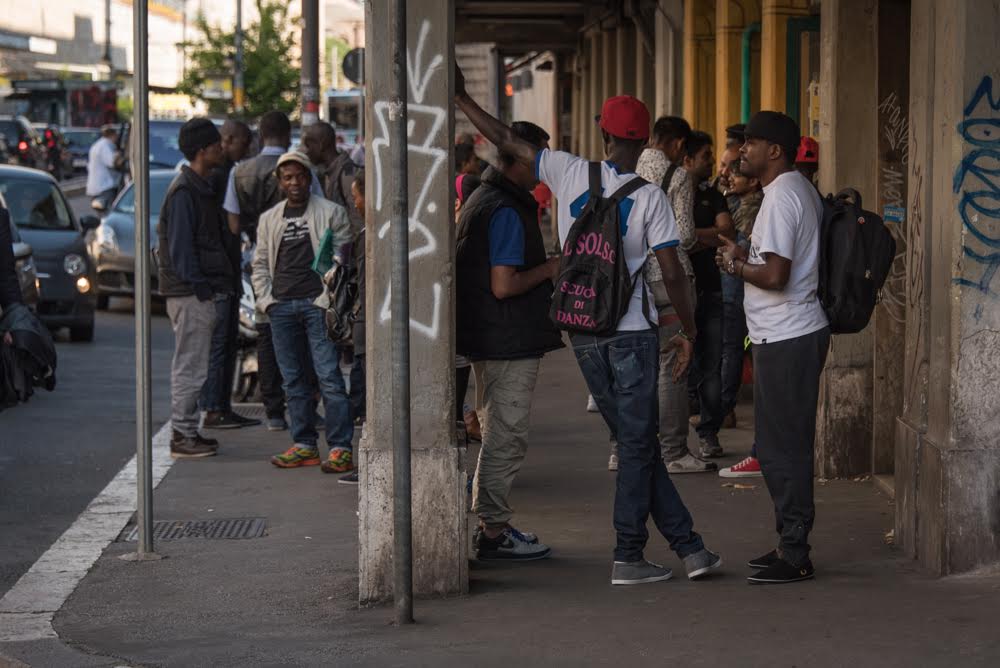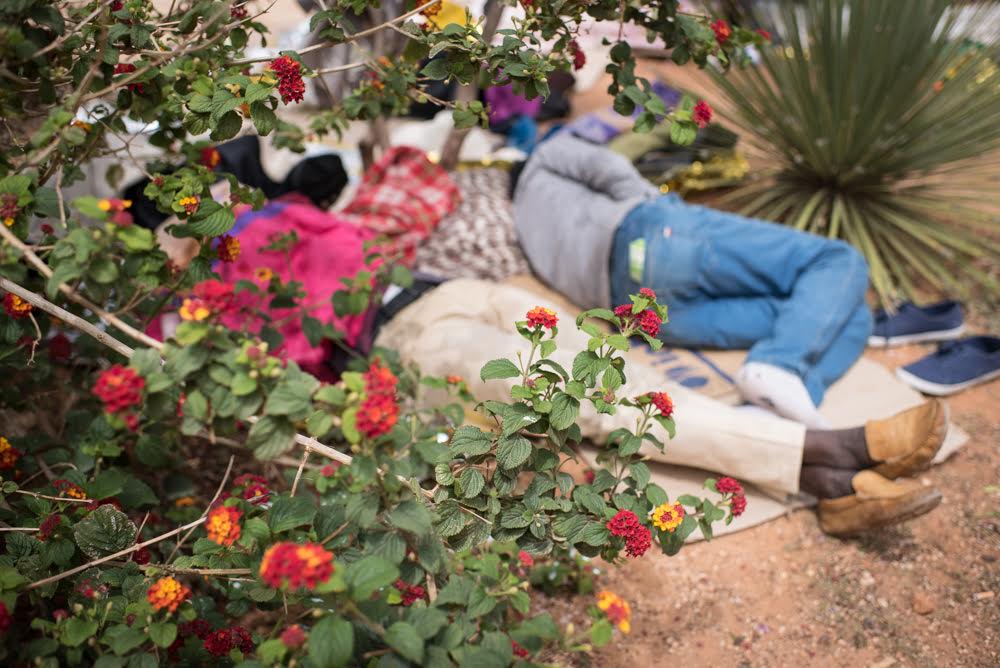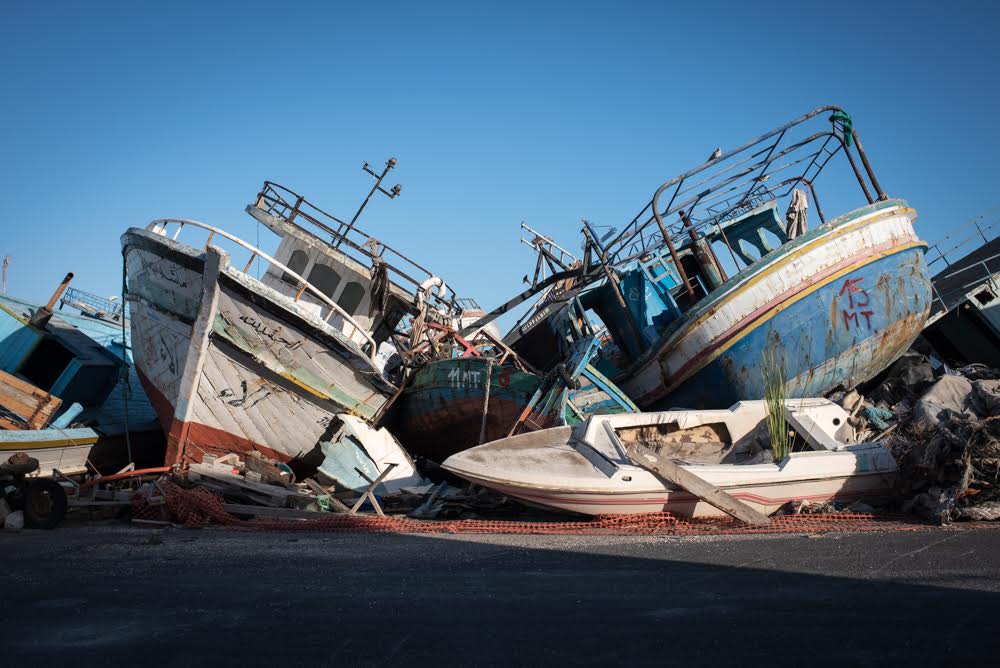Italy’s Stranded Migrants
Refugees in Italy have lived as second-class citizens since long before today's crisis.
Not far from Rome’s central train station stands an abandoned office building occupied by about seven hundred refugees, mostly from Somalia and Eritrea.
Aside from a large handwritten banner hanging from its windows that reads, “We are refugees, not terrorists,” the eight-floor structure looks like any other in the neighborhood, a business district dotted with international embassies and well-kept parks.
At the main entrance, a group of men unload a station wagon filled with sacks of white flour. They make a human chain, passing the bags from one person to the next, all the way to an elevator inside, and tell me the flour will be used to bake bread “our way.”
The process seems routine, synchronized by practice; the chain is interrupted only by the arrival of young mothers walking their children home from school.
Italians pass by without shifting their gaze, apparently used to such scenes in a country that’s been receiving “irregular” migration from Africa since the 1990s. I ask around and find the building’s inhabitants have been living in Italy with full asylum rights for six, eight, at times more than ten years.

One of them, Ali, a young Eritrean with a fashionable ponytail, tells me how he installed showers and stoves on each floor to accommodate families before complaining about his inability to find work, let alone decent housing.
“I have friends that made it to Switzerland and Sweden,” he says. “They have jobs, they can speak the language well, they can afford nice houses … they live like respectable people, while we remain stuck in the same place. Just look at where we live.”
Ali arrived in Italy in 2008, when he was sixteen. Immediately, he applied for asylum, a process that took two years. During this time, he was advised to stay in a state-run refugee camp, which offered neither Italian-language courses nor integration programs that could help him find employment after receiving his documents. With nothing to do, Ali got bored and left.
Today, eight years later and still unemployed, Ali says everything he has, he’s earned on his own. The national reception system, he tells me in the nearly fluent Italian he picked up while working small gigs, pushes refugees to fend for themselves with predictably mixed results.
“I am still okay, but most people like me became criminals a long time ago,” he says. “The system, the way it is here, forces us to. How else are we supposed to make money?”
On the Periphery
Ali’s story is fairly common among those seeking asylum in Italy. A recent study by Doctors Without Borders (MSF) found that more than ten thousand refugees live in abandoned spaces, handmade shacks, or camping tents throughout the country — and that’s an improvement over last year.
Relegated to the margins for extended periods of time, just one-third of documented refugees living in such places have regular access to services they are entitled to, such as health care.
For some, the proximate cause of their marginalization is the visa program. At the moment, asylum-seekers arriving in Lampedusa or Sicily are granted documents for seven days, and then they must decide whether to make their asylum claims in Italy or attempt to migrate to another country.
This arrangement — which other nations along the Balkan Route have also adopted — was originally a response to unpredictable waves of asylum-seekers. But at this point, the result is quite predictable.
Those who make their way to the northern borders with France, Switzerland, and Austria are met with increased patrols and fencing. The vast majority are repelled, and their week-long visas expire. They return from the border, now outside the system, and languish on the periphery of society.
The Stopgap
Working late into the night in mid-May, Viola De Andrade Piroli, a migration activist with the community group Baobab, welcomes groups of Eritrean teenagers into camping tents in an industrial alleyway just north of the city center.
Piroli can only provide a few beds before the tents fill up. She works as an operator for the rest of the night, calling the Red Cross, Save the Children, and, at times, church groups to find refugees a place to sleep.
“If we don’t do this, who will?” she asks me, before giving the teenagers directions to the Red Cross facility.
It’s a good question. In Italy and across Europe, states rely on volunteers and NGOs to carry out some of the basic functions of government. In Rome, for example, newly arrived refugees do not look to the state for housing. They seek out groups like the Baobab collective.

In the morning, another Baobab volunteer is on site to guide the refugees to the nearest UNHCR office, where they will file their asylum applications. During the day, Doctors for Human Rights (MEDU) offers free health clinics to those in need and psychologists to victims of rape and torture. And by nightfall, the Catholic organization Caritas distributes free meals at the train station for those without food — an independent humanitarian aid system running parallel to the state.
Tommaso Fabri, head of Italian mission for Doctors Without Borders, says they hope the government will take over for them in the future. But for now, “we are supposed to set up short-term projects to fill those gaps, and we are now substituting several government functions.”
The Italian government does provide shelter for asylum-seekers. But the demand often outpaces the spaces available in state institutions. In 2015, nearly 154,000 people arrived in Italy, while less than 97,000 beds were offered throughout the country.
The over-reliance on non-state actors leads to a lack of coordination, with many entities operating independent of one another and redundant services and waste proliferating. At best, volunteers and NGOs are a stopgap — an unsustainable solution to a humanitarian crisis.
Workers’ Rights
The Italian government is failing in another respect: preventing extreme exploitation. “20 percent of Italy’s GDP comes from the black market,” says Giovanni Abbate, a project manager for the International Organization for Migration (IOM) in Italy. “And much of this is based on underpaid migrant labor.”
Many of the most exploited work in the agricultural sector. In the recent book Ghetto Italia, authors Yvan Sagnet and Leonardo Palmisano describe a system where migrant workers are shifted from one harvest to another, working long days in the fields with little to no savings to show for it.
Migrant farm laborers are forced to not only pay their bosses for transportation and food, but to share a percentage of their incomes with “caporalatos” — middlemen who find work for laborers.
These operations are nothing new, having taken shape after the Balkan wars to exploit desperate Albanians and Bulgarians. But they’ve only become more widespread over time, recreating working conditions that wouldn’t be out of place in Grapes of Wrath.
Such labor systems shred labor rights not just for refugees, but for Italian citizens, who increasingly find themselves shut out of low-skilled jobs for refusing to accept meager wages.
Forced Assimilation
Italy’s laissez-faire approach to integration has created a segregated society of low-wage workers, often heavily exploited by employers and pushed into criminal activities to make a decent living.
Refugees have “basically taken the place of [the Roma] in Rome,” says Giuseppe De Mola, the lead researcher for MSF’s report. “We didn’t used to have so many homeless Africans in Rome. Now it’s normal to see them begging for change outside grocery stores. That didn’t happen before … We give them documents and leave them in the streets.”

Germany represents a cautionary tale in the other direction.
Hailed for its relatively humane response early on, the German government is now proposing a plan that would force refugees to participate in German language courses and job training programs or see their benefits cut.
In an effort to get newcomers into the labor market quickly, the government will also create one hundred thousand “one-euro jobs” — working arrangements originally designed for the unemployed and paid out through a government subsidy of between 1 euro and 2.50 euros an hour.
While unveiling the plan, Chancellor Angela Merkel said she expects “that people take the opportunities that we offer to integrate themselves.”
Selam Palace
Accessible only through a relay of bus lines, Rome’s Selam Palace shoots high above the suburban parking lots that surround it. While several East African squats sit in the city center — including the one where I met Ali — countless more can be found around the city’s outer edges. Selam Palace’s is the largest. For more than ten years, its three glass towers have been home to about one thousand East Africans.
I stand outside the structure, hoping to gain entrance and document the conditions, but Faisal, an Ethiopian with dreadlocks, tells me there is no point.
“So many journalists have come here, with photo cameras, with video cameras and made big stories, but nothing changes,” Faisal says. “NGOs come, doctors come, politicians come, everyone comes. It’s no secret we live here, and it only gets worse.”
Faisal says he had been living in a broken-down truck parked outside Selam Palace for the last seven years. He takes showers in public bathrooms and works odd jobs — collecting garbage, sweeping streets, chopping vegetables in soup kitchens — but rarely has enough to support himself, despite being fully documented for more than a decade.
“People with PhDs are living in the streets because the Italian integration system is an anti-integration system,” he tells me, drinking a beer with glassy eyes.
“I find my own way — the illegal way. We all work illegally, we all live illegally,” he says before pausing. “But I’m getting old just thinking about what job I’m going to do tomorrow.”